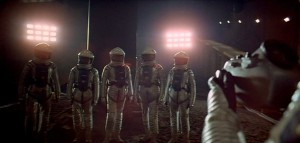Comparing Today’s Technology to 2001: A Space Odyssey
Comparing today’s technology with the 1968 movie, 2001: A Space Odyssey, reveals interesting parallels and contrasts. In some ways, almost two decades after the new millennium began, we have surpassed what the film makers imagined, but in others, we have quite a way to go.

Our cellular technology strongly contrasts communication methods displayed in the movie. When Heywood Floyd phones home from space, he’s able to see his daughter on a video screen. His wife is out, though, so Floyd says he’ll call back the next day. Obviously, Mrs. Floyd doesn’t carry a cell phone, and it’s doubtful such technology existed in the minds of the story’s creators, Stanley Kubrick and Arthur C. Clarke. After, all, even cordless phones were still years away. In 1968, they imagined video chat, but not mobile communication.
Continuing with video technology, there is one scene in the movie that seemed quite fantastical in 1968. When Floyd travels in a spacecraft for a meeting on the moon, TV screens play movies in the back of the passengers’ headrests. Those video screens are, of course, ubiquitous on commercial aircraft today.
We Have More-Advanced Security, Photography, and Entertainment
High-tech security in the movie included voiceprint recognition to enter a secure area. Today, voice recognition is widely used, as with Google Home, which can recognize the voices of six different users. We’ve also expanded electronic identity verification with the use of fingerprint and facial recognition.

Handheld photography in Kubrick’s flick is primitive compared to today’s technology, which has been largely integrated with our mobile communication. In the film, the astronaut photographer, responsible for capturing images of the monolith discovered on the moon, used a camera the size of a milk carton, which had to be rotated after every shot. https://goo.gl/images/QBnbm6
In gaming, the computer-generated chess board in the movie resembled two-dimensional version popular in the 1980s. In 1968, the idea of playing a game with a computer was quite novel, but by today’s standards, the film’s depiction was quite rudimentary, compared to contemporary 3-D interactive role-playing gaming.
Computers Today Have Nothing on HAL
Although the technology in everyday use today is ahead of what the movie predicted, the real-life development of a “conscious entity” computer like HAL hasn’t quite become mainstream. Advances are rapidly occurring in artificial intelligence, and computers have demonstrated the ability to learn, but they have miles to go before they can intentionally go off script.
As for long-distance space travel, the movie astronauts could visit locales lightyears away, thanks to suspended animation. Placing today’s space travelers in such a state has not yet been perfected, and we’re only just planning one-way trips to Mars.
In the 1960s, the new millennium seemed light-years away, and in the 40 years before 2001: A Space Odyssey was made, technological advances had been massive, from Kitty-Hawk to the moon landing. Expectations for future advances in space travel were likely exponential.
Instead of using resources to explore space, more dollars and brain power have been poured into developing faster, smaller, and more affordable technology. Perhaps once a plateau has been reached in that realm, more attention will be paid to worlds beyond our own. Fifty years after its making, 2001: A Space Odyssey still entertains us, in addition to making us wonder about just how far technology will go.
Disclaimer: I am a member of Netflix’s DVD.com Director’s program, which gives me free access to movies. If you sign up with my referral link, I may receive a referral reward.
Ann Silverthorn




Leave a Reply